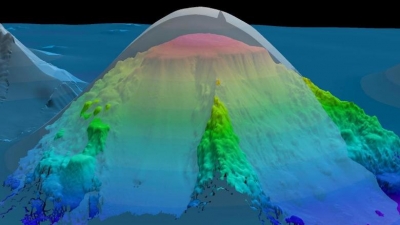
A seamount is an underwater mountain that rises from the ocean floor but does not reach the water’s surface. Most seamounts are volcanic in origin and are generally extinct. It is estimated that the Earth’s oceans contain more than 100,000 seamounts higher than 1,000 m.
During the course of their evolution and when they are in their eruptive phase, some seamounts may reach the sea surface due to the piling up of lava. However, wave action may erode the summit to form a flat surface. Such subsided, flat-topped seamounts are called ‘guyots’.
For a feature to be classified as a seamount, it must rise at least 1,000 m above the surrounding seafloor. Seamounts are found in every ocean basin on Earth. Because of their abundance seamounts are one of the most common marine eco-systems in the world.
In recent years their importance as biological hotspots has been recognized. Seamounts harbour an abundance of marine life from corals, sponges, sea anemones and fish to crustaceans such as crabs, barnacles, and lobsters.
Picture Credit : Google




